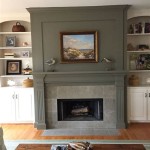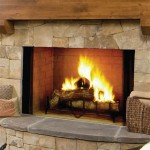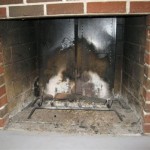Can You Replace A Gas Fireplace With A Wood Burning Insert?
The question of replacing a gas fireplace with a wood-burning insert is a common one for homeowners seeking to change the aesthetic, functionality, or fuel source of their existing fireplace. While seemingly straightforward, the process involves a number of considerations regarding safety, building codes, installation requirements, and the existing fireplace structure. This article will explore the feasibility of such a conversion, highlighting the key factors to evaluate before undertaking such a project.
A gas fireplace offers convenience and ease of use. They produce heat with the flick of a switch and require minimal effort in terms of fuel procurement and management. However, some homeowners find them lacking the traditional appeal and radiant heat offered by a wood-burning fire. Wood-burning inserts, on the other hand, provide the visual and sensory experience of a real fire, and often offer superior heating efficiency when properly installed and operated. However, they demand more labor in terms of sourcing, storing, and loading wood, as well as cleaning the resulting ash and creosote.
Before embarking on this type of replacement, a thorough assessment of the existing gas fireplace and chimney is critical. It is important to understand the existing system's construction, dimensions, and venting configuration. This information will determine the compatibility of the fireplace and chimney with a wood-burning insert. It is also crucial to consult with qualified professionals, such as chimney sweeps, certified wood stove installers, and local building inspectors, to ensure compliance with all applicable codes and regulations. These experts can provide valuable insights and guidance tailored to the specific circumstances of the project.
Key Point 1: Assessing the Existing Fireplace and Chimney
The existing fireplace and chimney are the foundations upon which any successful gas-to-wood conversion rests. A gas fireplace typically vents through a smaller diameter flue compared to a wood-burning fireplace. This is because gas combustion produces less exhaust and creosote. Wood-burning fireplaces require a larger flue to adequately expel smoke and combustion byproducts, minimizing the risk of dangerous backdrafts and chimney fires. The chimney must also be in good structural condition, free from cracks, leaks, and obstructions. A thorough inspection conducted by a certified chimney sweep is essential to evaluate the integrity of the chimney liner and masonry.
If the existing chimney is not appropriately sized or in good condition, it will likely require relining with a stainless steel flue liner of the correct diameter for the intended wood-burning insert. This liner plays a vital role in containing the hot combustion gases and protecting the surrounding chimney structure from heat damage and corrosion. The size of the flue liner is dictated by the manufacturer specifications of the wood-burning insert, and it is critical to adhere to these requirements to ensure safe and efficient operation.
The firebox itself must also be adequately sized to accommodate the wood-burning insert. Most gas fireplaces are designed with a shallow firebox to accommodate the gas burner and decorative logs. A wood-burning insert, on the other hand, typically requires more depth and width to accommodate logs of a reasonable size. In some cases, modifications to the existing firebox may be necessary, which can involve removing or altering existing components. This requires careful planning and execution to avoid compromising the structural integrity of the fireplace.
In addition, the hearth extension, the non-combustible surface extending out in front of the fireplace opening, must meet minimum size requirements for wood-burning appliances. This is to protect the surrounding flooring from sparks and embers that may escape from the firebox. The specific dimensions of the hearth extension are determined by local building codes. If the existing hearth is not large enough, it will need to be extended or replaced. This may involve significant construction work.
Key Point 2: Code Compliance and Permitting
Replacing a gas fireplace with a wood-burning insert is typically considered a significant alteration that requires a building permit from the local municipality. Building codes are in place to ensure the safety of occupants and the structural integrity of buildings. Installing a wood-burning insert without the necessary permits can result in fines, legal issues, and potential safety hazards. The permitting process typically involves submitting detailed plans and specifications of the proposed installation, including the dimensions of the insert, the flue liner, and any modifications to the fireplace or hearth.
Building inspectors will review the plans to ensure that they comply with all applicable codes, including those related to fire safety, chimney construction, ventilation, and clearances to combustible materials. They may also conduct inspections during and after the installation to verify that the work has been performed according to the approved plans and code requirements. Failure to comply with building codes can void insurance coverage and create potential liability issues in the event of a fire or other incident.
The International Residential Code (IRC) and the National Fire Protection Association (NFPA) provide guidelines for the safe installation of wood-burning appliances. Local codes may adopt or modify these guidelines, so it is important to consult with local building officials to understand the specific requirements in the area. Codes may address issues such as the minimum clearance between the insert and combustible walls, the type of materials that can be used for the hearth extension, and the requirements for smoke detectors and carbon monoxide detectors.
Furthermore, the Environmental Protection Agency (EPA) has regulations governing the emissions from wood-burning appliances. All wood-burning inserts sold in the United States must meet EPA emission standards. These standards are designed to reduce air pollution and improve air quality. When selecting a wood-burning insert, it is essential to choose a model that is EPA-certified and meets the applicable emission standards. Using older, non-certified inserts or stoves can contribute to air pollution and may be subject to fines or restrictions.
Key Point 3: Installation and Professional Expertise
Installing a wood-burning insert is a complex and potentially dangerous task that should be performed by qualified professionals. Incorrect installation can lead to chimney fires, carbon monoxide poisoning, and other serious hazards. Certified wood stove installers have the training and experience necessary to safely and correctly install wood-burning inserts, ensuring that they comply with all applicable codes and regulations. They also possess the knowledge to properly connect the insert to the chimney, seal any gaps or leaks, and test the system to ensure that it is functioning correctly.
The installation process typically involves several steps, including removing the existing gas fireplace, preparing the firebox, installing the flue liner, setting the wood-burning insert into place, connecting the insert to the flue liner, and sealing any gaps or cracks around the insert. The installer will also need to ensure that the insert is properly supported and that the hearth extension meets the required dimensions. They will then test the system to ensure that it is drafting properly and that there are no leaks or other problems. Using a manometer to test for proper draft and carbon monoxide detectors for safety are critical steps.
In addition to the physical installation, a qualified installer can also provide valuable advice on how to operate and maintain the wood-burning insert safely and efficiently. They can explain the proper techniques for starting and maintaining a fire, the types of wood that are best suited for burning, and the importance of regular chimney cleaning. They can also advise on how to prevent creosote buildup and reduce the risk of chimney fires. Regular chimney inspections and cleaning by a certified chimney sweep are essential for maintaining the safety and efficiency of a wood-burning fireplace.
Choosing the right wood-burning insert is also a critical decision. Inserts come in a variety of sizes, styles, and heating capacities. It is important to select an insert that is appropriately sized for the area that is to be heated and that meets the specific needs and preferences. Factors to consider include the size of the room, the insulation level of the home, and the desired heating output. A qualified installer can help to assess these factors and recommend an insert that is well-suited for the specific application.
Converting from gas to wood requires careful analysis of the existing chimney and fireplace. This also includes adherence to local building codes and the expertise of qualified installers. These professionals ensure the safe and efficient operation of the system. Ignoring any of these factors can lead to potential hazards and unsatisfactory performance.
Converting A Wood Burning Fireplace Into Gas Heat Glo

Can You Convert A Gas Fireplace To Wood Burning Stove Direct Stoves Resources
Can I Convert My Wood Burning Fireplace To Gas Woodlanddirect Com

Want To Convert Gas Wood Fireplace Full Service Chimney

Want To Convert Gas Wood Fireplace Full Service Chimney

Convert To Gas Installing Fireplace Inserts Doctor Flue

Should You Change Or Convert Your Wood Fireplace

Remodel Or Upgrade Your Existing Fireplace The Kernel Burner

Replacing A Gas Fireplace With Real Wood Buringing One Hometalk

Can A Wood Burning Fireplace Be Converted To Gas The Flame Company
Related Posts








